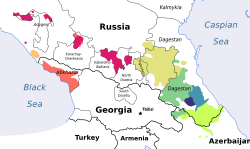| Tsudaqar | |
|---|---|
| Tsudakhar, Cudaxar | |
| цӀудхърила мецc’udqrila mec цӀудхъуран мецc’udquran mec | |
 Books in Tsudaqar | |
| Pronunciation | [ts’udqrilamets] [ts’udqranmets] |
| Native to | Russia |
| Region | Dagestan |
| Ethnicity | Tsudaqar people |
Native speakers | 33,000 in traditional areas (2010) |
Northeast Caucasian
| |
| Dialects |
|
| Cyrillic | |
| Language codes | |
| ISO 639-3 | – |
| Glottolog | cuda1238 Cudaxar |
| IETF | dar-x-HIS09130 |
 Tsudaqar | |
Tsudaqar (also Tsudakhar, Cudaxar [1] ) is a Dargin language, quite different from the literary variety, [2] spoken by over 33,000 people [3] in the Levashinsky and Akushinsky Districts, Novy Kostek in Khasavyurtovsky District, and Novokare in Babayurtovsky District, Dagestan. The village of Tsudakhar was the traditional center. It is considered to be threatened with extinction, being transmitted to children, but not by all families. [2] [4] In modern times, work is underway to revitalize Tsudaqar and create an alphabet for the language. [2]

